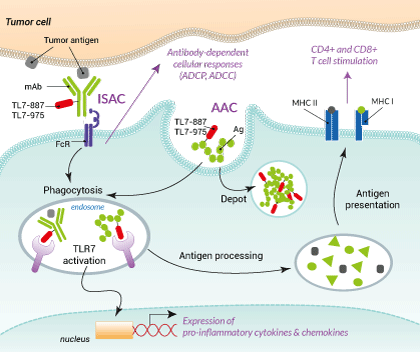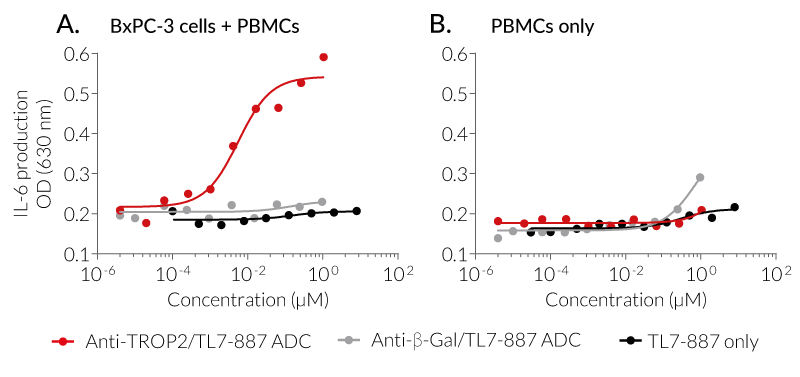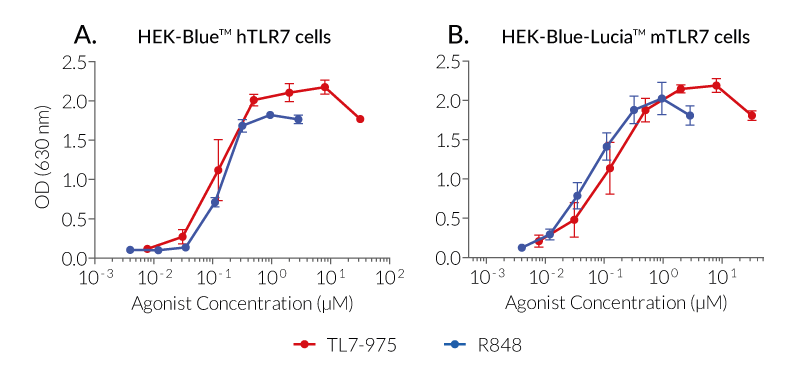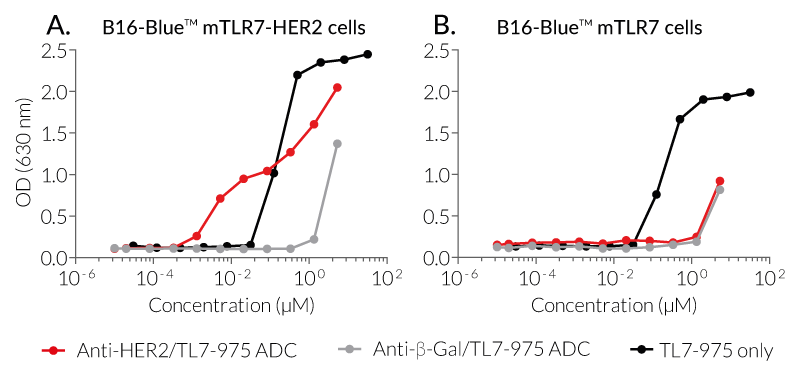Conjugatable TLR7 Ligands
| Product | Unit size | Cat. code | Docs. | Qty. | Price | |
|---|---|---|---|---|---|---|
|
TL7-887 TLR7 agonist with a maleimide group - VacciGrade™ |
Show product |
250 µg 1 mg (4 x 250 µg) |
vac-tl7887
|
|
||
|
TL7-975 TLR7 agonist with an azido group - VacciGrade™ |
Show product |
250 µg 1 mg (4 x 250 µg) |
vac-tl7975
|
|
TLR7 agonists for bioconjugation
InvivoGen provides two conjugatable PRR ligands that target the Toll-Like Receptor TLR7 to foster research on immunotherapeutic tools. These ligands have been synthesized from the well-known specific TLR7 agonist CL307 and designed to allow the generation of bioconjugates after attachment to a protein of interest (POI) with a chemical linker.
— TL7-887 is a ready-to-use reagent, bypassing the need for linker design. It features a maleimide group that reacts with free thiols on the POI.
— TL7-975 allows a flexible choice of linker for conjugation to the POI. It features an azido group that reacts with an azido-reactive group on the linker.
Synthetic TLR7 agonists, like natural microbial TLR7 ligands, mediate NF-κB/AP1- and IRF-mediated production of type I IFNs (IFN-α/β) and pro-inflammatory cytokines in TLR7-expressing cells (i.e. dendritic cells, B cells, and other myeloid cells) [1]. Thus, they have been extensively studied as immuno-modulatory agents in tumor and infectious disease models [2]. In order to enhance TL7-887 and TL7-975 cellular uptake and delivery to TLR7 in the endosome, both ligands were engineered from the base molecule CL307, which consists of the adenine analog CL264 coupled with spermine. This biocompatible cationic polyamine also anchors a spacer with the maleimide or an azido group.

Applications for TLR7 conjugatable ligands
Applications:
Conjugation to monoclonal antibodies to generate immunostimulatory antibody-drug conjugates (ADCs, also known as ISACs), or to antigenic peptide/proteins to generate antigen-adjuvant conjugates (AACs).
- ADCs (or ISACs) allow localized TLR activation and antibody-mediated effector functions [3,4].
- AAC vaccines allow the codelivery of antigen and TLR agonists to antigen-presenting cells (APCs) and thus, better antigen processing and presentation for the induction of adaptative immune responses [5].
Key features:
- Two formats: "pre-linked" for immediate use, or "click-chemistry compatible" for flexible choice of linker
- Biological activity has been confirmed using cellular assays
- Conjugation to a mAb (Anti-HER2-hIgG1 or Anti-TROP2-hIgG1) and subsequent activation of TLR7 has been validated using cellular assays
- Highly pure
- The absence of any bacterial contamination has been confirmed
 InvivoGen also offers:
InvivoGen also offers:
TL7-887 and TL7-975 are VacciGrade™, a high-quality pre-clinical grade.
Conjugatable ligands provided by InvivoGen are for research use only.
![]() Learn more about bioconjugation
Learn more about bioconjugation
References
1. Georg P. & Sander L.E., 2019. Innate sensors that regulate vaccine responses. Curr. Op. Immunol. 59:31.
2. Bahgchandani S. et al., 2021. Evolution of Toll-like receptor 7/8 agonist therapeutics and their delivery approaches: from antiviral formulations to vaccine adjuvants. Adv. Drug Delivery Reviews. 175:113803.
3. Gadd A.J, et al. 2015. Targeted activation of toll-like receptors: conjugation of a toll-like receptor 7 agonist to a monoclonal antibody maintains antigen binding and specificity. Bioconjug. Chem. 26(8):1743.
4. Ackerman S.E, et al. 2021. Immune-stimulating antibody conjugates elicit robust myeloid activation and durable antitumor immunity. Nat Cancer. 2(1):18.
5. Xu Z. & Moyle P.M, 2018. Bioconjugation approaches to producing subunit vaccines composed of protein or peptide antigens and covalently attached Toll-Like receptor ligands. Bioconjug. Chem. 29(3):572.
Specifications
TL7-887
Specificity: human/mouse TLR7 agonist
VacciGrade™ (preclinical grade)
Formula: C45H69N13O7
Molecular weight: 904 g/mol
Solubility: 20 mg/ml (22 mM) in water
Quality control:
- Purity: ≥95% (UHPLC)
- Sterility guaranteed
- The absence of bacterial contamination (e.g. lipoproteins and endotoxins) has been confirmed using HEK-Blue™ hTLR2 and HEK-Blue™ hTLR4 cells
- Endotoxin level < 5 EU/mg (measurement by kinetic chromogenic LAL assay)
- Activation of TLR7 by TL7-887 has been validated using cellular assays
- Conjugation to an Anti-HER2-hIgG1 or Anti-TROP2-hIgG1 mAb and subsequent activation of TLR7 has been validated using cellular assays
TL7-975
Specificity: human/mouse TLR7 agonist
VacciGrade™ (preclinical grade)
Formula: C29H45N13O3
Molecular weight: 624 g/mol
Solubility: 10 mg/ml (16 mM) in DMSO
Quality control:
- Purity: ≥95% (UHPLC)
- Sterility guaranteed
- The absence of bacterial contamination (e.g. lipoproteins and endotoxins) has been confirmed using HEK-Blue™ hTLR2 and HEK-Blue™ hTLR4 cells
- Endotoxin level < 5 EU/mg (measurement by kinetic chromogenic LAL assay)
- Activation of TLR7 by TL7-975 has been validated using cellular assays
- Conjugation to an Anti-HER2-hIgG1 or Anti-TROP2-hIgG1 mAb and subsequent activation of TLR7 has been validated using cellular assays
Contents
Note: these two conjugatable ligands are sold separately.
TL7-887 and TL7-975 are provided sterile, endotoxin-free, azide-free, and lyophilized.
Each product is available in two pack sizes:
TL7-887
- vac-tl7887: 250 µg
- vac-tl7887-1: 1 mg (4 x 250 µg)
TL7-975
- vac-tl7975: 250 µg
-
vac-tl7975-1: 1 mg (4 x 250 µg)
![]() The products are shipped at room temperature.
The products are shipped at room temperature.
![]() Store at -20 °C.
Store at -20 °C.
![]() Avoid repeated freeze-thaw cycles.
Avoid repeated freeze-thaw cycles.
VacciGrade™
VacciGrade™ is a high-quality pre-clinical grade. VacciGrade™ products are filter-sterilized (0.2 µm) and filled under strict aseptic conditions in a clean room*. The absence of bacterial contamination is assessed by a sterility test using a pharmacopeia-derived assay. The level of bacterial contaminants (endotoxins and lipoproteins) in each lot is verified using a LAL assay and/or a TLR2 and TLR4 reporter assay.
*Except for LPS VacciGrade™, which is prepared in a laminar flow hood dedicated to LPS.














